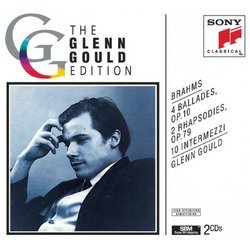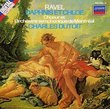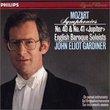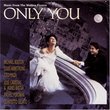| All Artists: Johannes Brahms, Glenn Gould Title: Brahms: 4 Ballades, Op. 10; 2 Rhapsodies, Op. 79; 10 Intermezzi Members Wishing: 0 Total Copies: 0 Label: Sony Original Release Date: 1/1/1993 Re-Release Date: 3/9/1993 Genre: Classical Styles: Forms & Genres, Ballads, Historical Periods, Modern, 20th, & 21st Century Number of Discs: 2 SwapaCD Credits: 2 UPC: 074645265124 |
Search - Johannes Brahms, Glenn Gould :: Brahms: 4 Ballades, Op. 10; 2 Rhapsodies, Op. 79; 10 Intermezzi
 | Johannes Brahms, Glenn Gould Brahms: 4 Ballades, Op. 10; 2 Rhapsodies, Op. 79; 10 Intermezzi Genre: Classical
Glenn Gould's accounts of the late pieces, recorded in 1960, are among the most affecting statements he made. He manages to balance the music on the edge of an almost unbearable emotional intensity without becoming larmoya... more » |
Larger Image |
CD DetailsSynopsis
Amazon.com essential recording Glenn Gould's accounts of the late pieces, recorded in 1960, are among the most affecting statements he made. He manages to balance the music on the edge of an almost unbearable emotional intensity without becoming larmoyant or dipping into salon sentimentality. The result is downright disturbing and depressing. But few pianists have achieved such extraordinary distillations of Brahms's late style as Gould does here, conveying painful passion held in check and peering into the counterpoint, yet maintaining an overall fluidity within profound emotional stasis. The recording is very present. --Ted Libbey Similarly Requested CDs
|
CD ReviewsNot what you might expect from Gould. I Hate Amazon | 02/20/2000 (5 out of 5 stars) "This recording is proof that there is more to Gould than the strict Bach-ian architecture he is most renowned for. Here we see a gushing romantic revealing something intimate, something we feel almost ashamed to have witnessed but are grateful for the trust. One can imagine him in his famous dwarfish chair, huddled over his fingers, breathing on the keys, unable to stifle an occasional ecstatic hum as he gets carried away with his own recreation, allowing something repressed to spill out in the notes, betraying his ideal of "artist as zero" with the filter of his emotion.Here Gould does the unspeakable--rubato, dynamic development, damper pedalling...in short, he plays pianistically. His technique is excellent, as expected, though it might make one wonder why anyone with such a controlled pedal technique would shun its use.Also, the interpretation is, for Gould, remarkably faithful to the score. There is the occasional exception, most notably in the second ballade where he plays a little bit with the broken chords, but overall he doesn't succumb to the idiosyncrasies we have come to expect from him.As something of a bonus, the booklet contains a fictionalized Gould/gould interview which is pretty funny, though it apparently wasn't actually scripted by him.Just to clarify, the second disc (the collection of intermezzi) was recorded in the 60's, but the first disc (ballades and rhapsodies) was digitally recorded in 1982, shortly before his death. There's something about that which lends something vital to this recording, akin to Horowitz's rendition of Isolde's Liebestod on his final recording. Beautiful and heartbreaking music making." LIKE NO OTHER DAVID BRYSON | Glossop Derbyshire England | 07/14/2004 (5 out of 5 stars) "Gould was not too sure about Beethoven and downright contemptuous of Mozart, but about Brahms he entertained no doubts at all. Let me say without more ado that this disc has some of the greatest Brahms-playing I ever heard or ever expect to. If one thing more than any made an impression on me, it was his handling of the central part of the G minor rhapsody. This sequence is in a uniquely Brahmsian mood and tone, like the passages marked `tranquillo' in the middle of the finale of the second symphony and in the slow section of the tragic overture. None of these are lyrical in style and Brahms doesn't actually say `tranquillo' here in the rhapsody, but the feel is the same. The one thing I can put my finger on explicitly is the way Gould gives the right prominence to the monotonous triplet accompaniment, but there's more to it than that, and as the scripture has it `the hair of my flesh stood up'. Except in the B minor rhapsody, Gould uses the sustaining pedal a great deal and to great effect. The first ballade made an impact right away. It's taken at a fair tempo for `andante', just slower than I'm used to, and very emotional and theatrical. The other three don't lend themselves to the same kind of treatment, but my impression in all four was much more `personal' than I get from Katchen or Michelangeli. There is a fair amount of rubato, but not as much as he makes it seem, if that makes sense. In the two rhapsodies the style of playing is distinctly different from the rest - less pedal and very little latitude in the tempo. This suits the B minor very well, I found. The G minor is taken at a fairly deliberate pace, and no wonder considering the composer indicates `non troppo allegro'. As a rule I am no stickler for the observance of repeats, but this G minor rhapsody is so marvellously done that I longed to hear the first section done again, and there was nothing else for it but just to repeat the whole thing. By the end of the first disc I was beginning to suspect that I was going to find nothing eccentric or perverse in the entire recital. I needn't have worried. Gould becomes a little more wilful in the selection of ten intermezzi, but there was only one that I simply couldn't take. Oh the poor A major piece from op 76! What did it do to deserve this? It is one of my favourites of the lot, and it has more ways of perming 3 against 2 in the rhythm than I would otherwise have thought possible. I was a fair way into it before I could even recognise what I was listening to. Katchen always seemed to me a little unadventurous in his playing of it, but I shall go back to his account with relief not to say desperation after the mauling Gould dishes out. Elsewhere Gould's originality wins me over even when I'm used to a different approach. The B minor that stands first in op 119 is marked `adagio', and both Katchen and even more so Serkin understand this as a really slow adagio. Gould made me think. Adagio in Brahms seems to vary in its meaning. The last section of the alto rhapsody is adagio but it must not be dragged, and one of the best performances I ever enjoyed of the slow movement of the violin concerto was by Kremer who took a very flowing tempo indeed. Again the first E major from op 116 (also adagio) is given a fanciful interpretation that absolutely delighted me, although I continue to admire the more normal manner of Kissin. The B flat minor is more low-key and and `romantic' than in Horowitz's typically alert reading that I shall always love, but I find I can take it either way. The great A major from op118 is the last piece here, and I was gratified to hear Gould handle the middle section in much the way I try to do it myself. He makes the repeat (non-negotiable in this instance) and at the second time round he brings out the lower melody - indeed throughout the whole recital his voicing of those very Brahmsian inner parts is a consistent pleasure. In the E flat minor, surely one of the greatest things in the whole literature of the piano, his performance is quite awesome, and nothing short of this will ever satisfy me again. My own idea of the left-hand figuration in the middle section is staccato with very little pedal, which is not how Gould does it. I haven't lost my hankering for that, but until I hear it done like that by a player of less ill repute than myself I shall have to take Gould as my point of reference. `This nut is a genius' was Szell's famous summing-up of Gould. The overwhelming impact of these two discs is of sheer raw greatness. The recorded sound is really very good, and if you can put up with the liner-note you will be able to read what it has to say not only in French and German as well as English, but also in Italian. The music has to go on to a second disc, although it means that each disc contains only just over 40 minutes' worth each. If it had been 4 minutes each of this quality I would still have wanted the set." A different and intriguing approach to Brahms Bertrand Jacques | Louveciennes France | 09/04/2000 (5 out of 5 stars) "If I may, Glenn Gould's contribution is to leave the beaten tracks of romantism and to lead us into unknown territory. His fairly radical options seem to unravel the texture of Brahms' contrapuntic scores. In doing so, Gould gives us the opportunity of a rare feast...Combined with more classical versions (could I suggest Julius Katchen and Arturo Benedetti Michelangeli ?), this is a vision that makes us realise the depth of the music's underlying harmony.Contrary to the previous reviewer (whose point on the intermezzi makes fascinating reading...), I bought this CD for the ballads. Two of them are particularly remarkable. The tempo of the first one is so stretched that it magically takes you to the melancholic views of the North Sea beaches that inspired Brahms. On the contrary, the left hand's presence in the third ballad (to be opposed to Michelangeli's interpretation which is led by a very nervous right hand) brings an unsuspected warmth in the middle section.Do you really like Brahms ? If you do, you will join me in thanking Glenn Gould for leaving us this recording..."
|

 Track Listings (6) - Disc #1
Track Listings (6) - Disc #1







